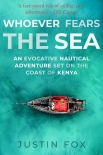Whoever Fears the Sea, Justin Fox [i love reading .TXT] 📗

- Author: Justin Fox
Book online «Whoever Fears the Sea, Justin Fox [i love reading .TXT] 📗». Author Justin Fox
‘Sit down, sit down, Mr Paul, pour us some tea,’ he said in a creaky voice. ‘I am Fundi Daud Bwana. Lots of sugar. Pleased to meet you. They say you are interested in mtepes.’
‘Yes, very much. Husni told me you were a mtepe fundi.’
The man laughed, his face crumpling into a topographic map. ‘Husni exaggerates. When I was young, I was an apprentice to a great fundi from Lamu. He taught me everything I know. It was before the European war. The second one.’
Bwana’s mind was still sharp and he’d forgotten nothing. He explained in detail how the mtepe was constructed. ‘You see, Mr Paul, in European shipbuilding, the ribs are the first to be put in place, then the hull is attached to them. But with a mtepe, the shell of the hull is made first, then the ribs put in. The reason is simple: you cannot stitch the planks together if the ribs are in the way.’
Initially, Bwana explained, mangrove timbers had to be bent into shape over open fires, then laid edge to edge and fastened together with wooden pegs. Next came the sewing. Holes were drilled with a hand auger and the rope was passed back and forth by two men, like the lacing of a shoe. The rope was stretched, and each stitch secured by a peg knocked in to wedge it. Then the hole was plugged with tree gum.
Lastly, a paste of pounded mangrove bark and vegetable oil was smeared on everything as a preservative. This had to be done every few months for the rest of the mtepe’s life to stop the hull from rotting. It was a painfully laborious process.
‘No nails, Mr Paul. That is the beauty! In the old days they believed that when a ship built with nails sailed over a magnetic mountain on the ocean floor, its nails would be drawn out like teeth and she would sink. Not with a mtepe! But one bad stitch can sink a ship, Mr Paul, and the hull has more than four thousand of them. Every plank has to fit together perfectly,’ said the fundi, laying his calloused hands together. ‘Exactly. Over a length of sixty feet. Not even a gap the size of paper, understand? In a nailed boat, if there’s a gap in a seam you just hammer in some caulking. If you do that in a sewn boat, you open the gap wider. Then you sink.’
‘Do you think there are any fundis who could still build a mtepe?’ asked Paul.
Bwana took a slurp of his tea. ‘Perhaps one or two old fools. But they would need my help,’ he said with a wink.
‘Did you ever sail one?’ asked Paul.
‘I made a few voyages as crew when I was young,’ said Bwana. ‘We mostly worked the inshore channels, carrying cattle, boriti, salt, pottery … in my grandfather’s time, they carried slaves. But never coconuts.’
‘Why not coconuts?’
‘Bad luck — they loosen the stitches!’ said the old man. ‘We mostly travelled using poles and oars. We had a sail, of course, square and made from palm fibre. Unfortunately, mtepes are not very good sailors. They are leaky boats too. We had to bail water out every hour. It was hard work. But mtepes were good for beach landings. The hull is more, how can I say, forgiving than one built with nails. And they were graceful, Mr Paul, the most graceful of all dhows.’
Returning to the beach, Paul and Husni saw a motorboat waiting in the shallows, a WWF logo on its side. A teenager hopped out and sprinted up to them. ‘Come quickly, they are hatching!’ he cried.
The motorboat sped them the short distance across the bay to Kiwayu. A game guard met them on the beach and led the group hastily up a sandy path, over a hill to the island’s wild eastern shore and north along a line of low cliffs. By now, the sun had set and waves pounded the rocks below in loud detonations. When they came to the crest of a dune, the guard stopped and crouched down. A stick marked an indentation in the sand. ‘It’s here,’ he said to the teenager.
The lad began gently scraping away the soil. Just then a miniscule turtle popped to the surface like a cork. Soon, there were a dozen of them hurtling down the dune, using their flippers to paddle across the sand, the roar of the waves acting like a magnet. Paul walked beside them, brimming with emotion. He would be their escort, making sure they reached the water safely. The baby turtles came to a wave-cut ledge and, without hesitating, tumbled over the precipice, their white bellies flashing in the dusk as they cartwheeled to the beach below. For a human baby, this would be the equivalent of a five-metre fall within a minute of being born, Paul reckoned.
He glanced across the beach and noticed that each man was herding his own flock of hatchlings and shooing away the ghost crabs. The cove had become one big maternity ward. The teenager came over and told him to resist the temptation to pick up the turtles and carry them to the water, as all their geomagnetic imprinting took place during the mad dash for the surf: this was what allowed them to return to that very beach, years hence, when they were adults.
Paul’s batch of reptiles neared the water, leaving caterpillar trails in the hard sand. A wave broke on the shore and he jumped back so as not to wet his shoes. When he looked again, the backwash had swept the beach clean. Somewhere in the surf, infant turtles were swimming for their lives into a darkening deep, thick with predators.





Comments (0)